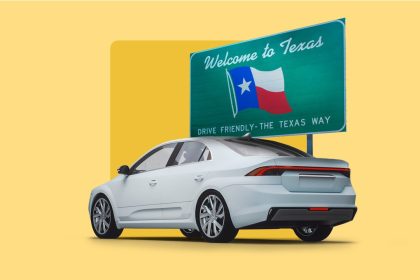Photo by Getty Images; Design by Bankrate
Key takeaways
- Gap insurance — guaranteed asset protection — is specifically designed for drivers with outstanding loan balances on their vehicles.
- It is typically only available for vehicles less than three years old that have had no more than one prior owner.
- Gap insurance is more robust than loan/lease coverage, which typically limits claim payouts to 25 percent of the car’s actual cash value.
- It is typically more expensive to purchase gap insurance from a dealership than on your own from an insurer.
Did you know your new car loses about 10 percent of its value the moment you leave the lot? If it’s stolen or totaled in an accident, your insurance company pays only its actual cash value minus depreciation, not what you still owe on the loan. The gap left between your claim payout and loan balance can leave you making payments on a car you no longer have. However, gap insurance can bridge this difference. Bankrate breaks down how this type of insurance for new vehicles could help you avoid large out-of-pocket expenses in the Golden State.
What is gap insurance?
Gap coverage helps pay the difference between what you owe on your auto loan and the payout you receive from your insurer if your vehicle is stolen or rendered a total loss. While it does fill in a financial gap, that is not where this coverage gets its name — it actually stands for “guaranteed asset protection.”
It’s easiest to understand gap insurance with an example. Let’s say you used a $25,000 auto loan to purchase a new vehicle, and you carry a full coverage car insurance policy. Your vehicle is stolen from your driveway, and you file a claim with your insurance provider. Your insurer, however, factors depreciation into your claim payout and only gives you $20,000. In this instance, gap insurance could help cover the remaining $5,000 you owe on your auto loan.
Typically, gap insurance is only available for brand-new vehicles or for models that are less than three years old. Without gap insurance, your car insurance company is not concerned about the outstanding balance on your auto loan. If you’re planning on financing most or all of your vehicle purchase, gap insurance could be an important safeguard. If you make a substantial down payment, you may have less risk of being upside down on your loan and needing this type of insurance.
How does gap insurance work in California?
Gap insurance in California is generally an option to purchase if:
- You are the original loan or lease holder on a new vehicle purchase
- You have both collision and comprehensive coverage
- The vehicle is less than three model years old
Gap coverage is commonly confused with loan/lease gap coverage and new car replacement coverage, but they are different. Gap coverage is a way to financially protect yourself if you have an outstanding loan on your vehicle and experience a total loss. Loan/lease coverage is very similar, but typically has a claim payment limitation of 25% of the car’s actual cash value (ACV) or $25,000, whichever is less. New car replacement, on the other hand, helps drivers obtain a new version of their damaged vehicle’s make and model after a total loss. Gap insurance does not pertain to purchasing a new vehicle.
When do you use gap insurance?
In insurance terms, a total loss occurs when the cost to repair your vehicle exceeds its depreciated value (also known as actual cash value or ACV). This might happen if your vehicle is:
- Destroyed by a fallen tree
- Totaled in an accident
- Stolen and never recovered
- Inoperative due to complete engine failure
If your vehicle is deemed a total loss and the insurance payout is not enough to cover your outstanding loan balance, gap insurance can help. Remember, gap insurance is only for total losses, though. It does not help with smaller repairs or routine maintenance. For instance, if you run a stop sign and get hit but your car is only somewhat damaged, gap coverage would not apply. However, if you have collision insurance, that can help pay for repairs in this instance.
Where to buy gap insurance in California
Many — but not all — major insurers write gap insurance policies. For example, Geico, one of the largest auto insurance companies in California, does not.
If you’re buying a new car, the dealership might offer you gap insurance — but most experts suggest skipping it. Dealership policies usually cost more than those from regular insurers and are often rolled into your auto loan, meaning you’ll pay interest on top of the premium.
Gap insurance vs. other coverage options
Many types of car insurance can offer financial protection for the investment you’ve made in your vehicle. However, each coverage type pertains to specific situations, and it can be difficult to keep them all straight. In the table below you can see how gap insurance works in California, along with comprehensive and collision coverage.
| Coverage type | What it covers | Who offers it |
| Gap insurance | Only covers your car if it is deemed a total loss from a covered claim. Pays the difference between the ACV and your remaining loan balance, minus past fees, negative equity and deductible. | Offered by many insurance companies and most dealerships and lenders. |
| Loan/lease coverage | A version of gap insurance that limits the claim payout. A typical cap is 25% of the car’s ACV or $25,000 | Offered by many insurance companies and most dealerships and lenders. |
| Comprehensive coverage | Pays for damage if your car is damaged by something other than a collision, including fire and vandalism. | Sold through insurance companies |
| Collision coverage | Covers damage sustained to your car from colliding with another vehicle or object, such as a sign, fence or tree. | Sold through insurance companies |
Frequently asked questions
Why we ask for feedback
Your feedback helps us improve our content and services. It takes less than a minute to
complete.
Your responses are anonymous and will only be used for improving our website.
Help us improve our content
Read the full article here
















